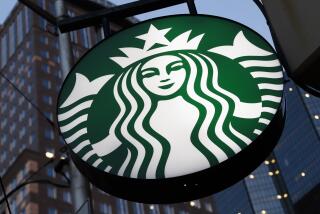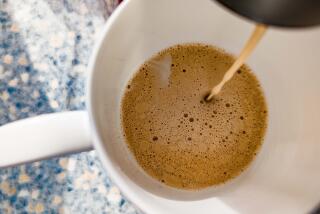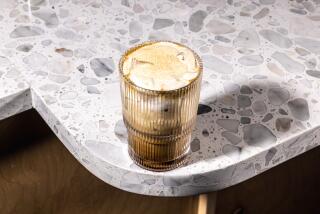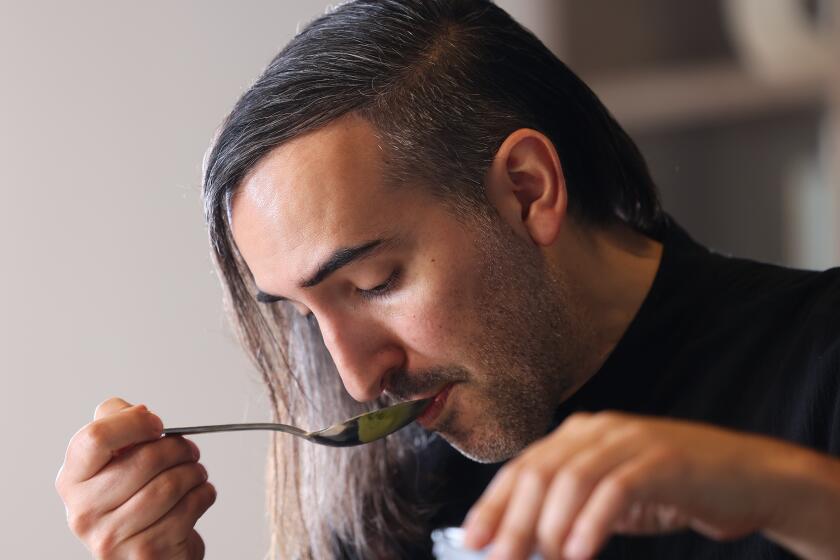FROM THE GROUNDS UP
Does this sound familiar?
You order a cup of coffee at a coffeehouse, and it’s really delicious.
So you buy the $10-a-pound coffee they use, take it home, carefully brew up a pot, and it’s, well, not so delicious. In fact, it doesn’t taste much better than the canned coffee you got at the supermarket.
Or you go out someplace nice to eat, have a marvelous dinner, order after-dinner coffee and it’s extremely so-so.
Ted R. Lingle, executive director of the Specialty Coffee Assn. of America in Long Beach, feels your pain.
He and his membership, the largest of the coffee trade associations, want you to keep buying those expensive beans. In the United States, about 20% of the 660,000 tons of coffee beans consumed at home are premium coffee beans, Lingle says.
Another 528,000 tons of coffee beans are consumed away from home, but only 6% are top-quality beans. Most restaurants are simply skimping, Lingle says.
The remedy, Lingle hopes, will be a campaign his association is launching this month to improve commercial- and home-brewing methods so the true flavor of premium coffee beans can come through. Encouraged by the rising popularity of coffeehouses, Lingle is convinced that consumers will pay extra for good coffee at home, work and even at Spike’s Diner.
This is not going to be easy, Lingle says, because brewing the perfect cup of coffee--one that tastes as good as it smells--is a science.
Karl Poetes says Lingle is right. When Poetes was a chef in Germany, he never gave coffee a second thought, he says. But when he opened his coffeehouse, Caffe Carluccio in Newport Beach, he discovered coffee wasn’t such a simple beverage to prepare.
He says it took him two years and much help from Lingle’s association to get it just right. “Ted wrote the book on coffee brewing,” Poetes says.
Lingle, a member of the family that in 1920 established Lingle Bros. Coffee, a food service supplier in Bell Gardens, published his 59-page manual, “The Coffee Brewing Handbook,” last year in an attempt to revive brewing standards for the food service industry.
You can buy a copy for $37, but be prepared for page after page of charts, graphs, tables and instructions on the brewing process and how to monitor it with scientific instruments. A shorter, simpler version for householders is his next project.
Right now, properly home-brewed coffee is the best you can get, Lingle says, but the vast majority of home brewing methods are still far below state-of-the-art. “They buy $8-a-pound coffee, take it home and put it in a $30 coffee maker. Then they blame the beans,” he says.
Most commercial methods are only slightly--if any--better.
Consequently, he says, the typical cup of coffee still conforms to the American tradition of bitter or grassy, too weak or too strong.
The reason for all the badly brewed coffee, he says, is that extracting the flavor from the coffee bean is an extremely complicated chemical process. The acids and other flavorings that compose coffee’s subtle taste dissolve at different rates and temperatures.
If the brewing water is too cool (below 195 degrees) or too hot (above 205 degrees) some of the pleasing flavor elements are not extracted from the beans. You don’t get the full coffee taste.
If brewing takes too long or the coffee is ground too fine, too much is extracted. The result: unpleasant flavor elements drawn into the brew, making for bitter coffee.
Inexpensive coffee may come from the same bushes as the best coffee, but it has rotten or otherwise defective beans, called “stinkers.” Just one stinker and you can taste it, Lingle says. They are removed by hand from premium coffee.
Lingle’s book gives the scientific standards for good coffee, and he has assembled a kit of test instruments small enough to be rolled in a canvas sleeve and carried in a briefcase.
A conductivity meter measures coffee concentration. A pH meter measures acidity. An electronic thermometer makes sure brewing temperature is correct. A small electronic scale, a silver-plated tasting spoon and a screwdriver complete the kit.
The kit has made possible his association’s “Gold Cup” program, in which trained inspectors go by invitation to restaurants and test the coffee. If it meets association standards, a Gold Cup plaque is presented.
It is the association’s attempt to combat a trend among restaurants to use cheaper, “high yield” coffee beans, which, according to Lingle, are simply poor-quality beans brewed weak to minimize their bitterness.
About 150 technicians nationwide have been trained and equipped. The program is being formally launched during the association’s annual meeting now underway in New Orleans, but two coffeehouses have already received the award, Un Grande Cafe in Chicago and Caffe Carluccio in Newport Beach.
At Caffe Carluccio, Poetes uses five water filters and a large reverse-osmosis device to remove enough of the minerals from Newport’s hard water. This is most important, he says, because his coffee is 98.2% water.
He uses an electronic scale that can weigh to a hundredth of a pound so he can be sure to use exactly 0.35 of a pound of premium coffee beans per half-gallon of water.
He uses a precision grinder set to what he found, after two months of experimentation, to be the optimum grind.
He uses a coffee maker that dispenses the water at the right temperature, maintains it and spreads the water evenly through the grounds.
And he uses insulated jugs, not hot plates, to keep the coffee warm--but only for 20 minutes. If it’s not consumed by then, he throws it out; coffee degrades that quickly, he says.
A cup of Poetes coffee costs 95 cents to $2.05, but as he and other coffeehouse proprietors have discovered, plenty of people are willing to pay the price.
“I think Starbucks [the coffee merchant chain] and our association have done a lot to educate people to be more demanding,” Poetes says. That and the decline in social drinking in bars are fueling the coffeehouse boom, he says.
Lingle’s long-term strategy is to make a restaurant’s coffee as important to customers as the wine list. That will make restaurateurs pay coffee the respect it deserves, he says.
“The wine industry is our model,” he says. “Twenty years ago, you could offer red, white and pink and that was enough. Now restaurants are judged by their wine lists.”
Lingle predicts he’ll have won over more than 20% of the sit-down restaurants in America during the next six years. But will he ever be able to sign up Spike’s Diner and the like?
“There’s always an enlightened few,” he says. “The food service industry in general is beginning to take notice, at least the smart ones.”
(BEGIN TEXT OF INFOBOX / INFOGRAPHIC)
The Perfect Cup
Here are the seven commandments of coffee brewing from Ted R. Lingle, executive director of the Specialty Coffee Assn. of America and author of “The Coffee Brewing Handbook”:
1. Use good water.
Water should have a low mineral content--less than 300 parts per million but ideally between 50 and 100. Don’t go lower than 10 or you’ll get that distilled-water taste.
Tap water in Orange County generally has 400 to 800 parts per million, so you’ll probably have to use bottled water or treat your tap water.
2. Use the correct ratio of water to coffee grounds.
The ideal ratio is 3 1/4 to 4 1/2 ounces (weight) of ground coffee to two quarts of water.
3. Use the right grind.
How long it takes your brewer to brew coffee determines what grind you should use. The longer it takes, the coarser the grind should be.
You must find your ideal by experimentation, but you can start by buying beans from a coffee merchant and asking the clerk to recommend a grind to match your brewer.
Have the beans ground at the store. Few home coffee grinders are as consistent as the one behind the counter.
Lingle suggests that you assume you’ve been using too fine a grind. Use a coarser grind and add a little extra, then taste the results. Trust your palate. Keep trying coarser grinds until the coffee doesn’t taste as good as the previous batch.
What you’re doing by adjusting the grind is changing the amount of flavoring extracted from the ground beans. When you’re extracting about 80% of what the beans have to offer, you’ll have your ideal taste.
4. Use the optimum method.
The best home method is drip filtration. Coffee grounds go into a cone containing a filter, then water is poured into the cone. The water passes only once through the grounds, and if the proper grind-to-time relationship is used, the ideal cup of coffee results.
Your grandmother’s percolator, which boiled and recirculated the coffee through the grounds, is “the worst method of brewing coffee ever devised by mankind,” Lingle says.
5. Use your brewer properly.
Water must be between 195 and 205 degrees Fahrenheit and should remain within that range during brewing. And the water must be turbulent enough to evenly wet the grounds and flow uniformly through them.
Most automatic home coffee makers fail in both these areas, Lingle says. A manual drip cone allows more control.
Stop heating the water just before it comes to a boil. You can control water temperature precisely by using a kitchen thermometer.
You can create the proper turbulence by pouring the water into the cone in a circular motion.
6. Use a good filter.
The most common type is made of paper, and while it provides the clearest coffee, it does not provide the ideal taste.
Some paper adds an undesirable flavor to coffee. All paper absorbs some of the tasty elements extracted from the grounds. And paper is slow to let the brewed coffee pass through, usually extending brewing time too long.
For taste, the best filter is an ultra-fine metal screen. Rinse it, but never wash it with soap or detergent.
7. Make it, then drink it.
Coffee tastes best when it’s freshly brewed. Using a heat source to keep coffee warm will cause some of the water to evaporate, making ideal coffee too strong. It also will break down good-tasting coffee elements into their bitter byproducts. This breakdown eventually occurs, but maintaining brewed coffee at 180 degrees in an insulated container will keep it palatable longer.
More to Read
Eat your way across L.A.
Get our weekly Tasting Notes newsletter for reviews, news and more.
You may occasionally receive promotional content from the Los Angeles Times.










